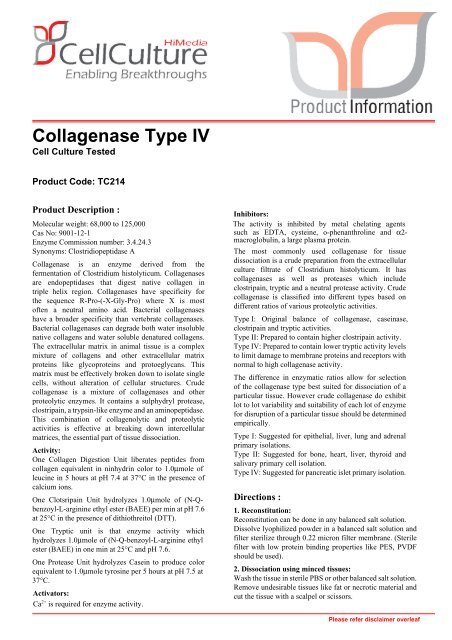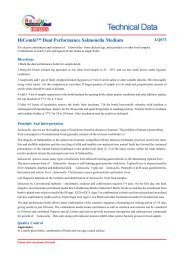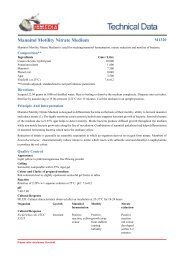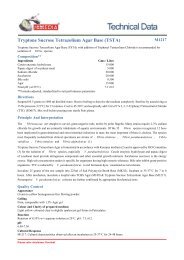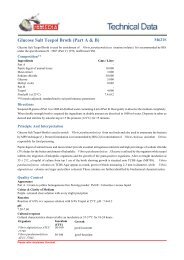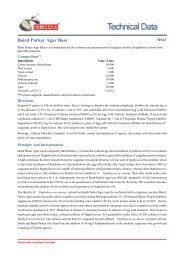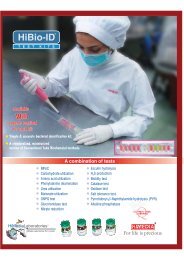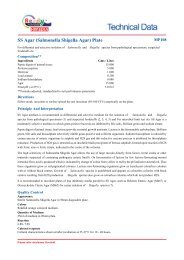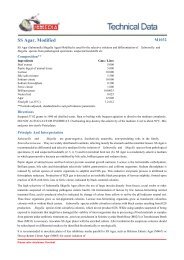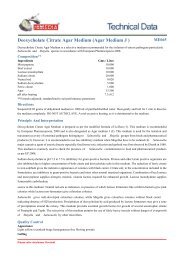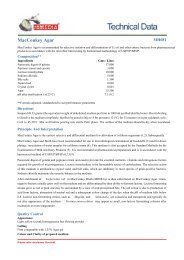Collagenase Type IV - HiMedia
Collagenase Type IV - HiMedia
Collagenase Type IV - HiMedia
You also want an ePaper? Increase the reach of your titles
YUMPU automatically turns print PDFs into web optimized ePapers that Google loves.
<strong>Collagenase</strong> <strong>Type</strong> <strong>IV</strong><br />
Cell Culture Tested<br />
Product Code: TC214<br />
Product Description :<br />
Molecular weight: 68,000 to 125,000<br />
Cas No: 9001-12-1<br />
Enzyme Commission number: 3.4.24.3<br />
Synonyms: Clostridiopeptidase A<br />
<strong>Collagenase</strong> is an enzyme derived from the<br />
fermentation of Clostridium histolyticum. <strong>Collagenase</strong>s<br />
are endopeptidases that digest native collagen in<br />
triple helix region. <strong>Collagenase</strong>s have specificity for<br />
the sequence R-Pro-(-X-Gly-Pro) where X is most<br />
often a neutral amino acid. Bacterial collagenases<br />
have a broader specificity than vertebrate collagenases.<br />
Bacterial collagenases can degrade both water insoluble<br />
native collagens and water soluble denatured collagens.<br />
The extracellular matrix in animal tissue is a complex<br />
mixture of collagens and other extracellular matrix<br />
proteins like glycoproteins and protoeglycans. This<br />
matrix must be effectively broken down to isolate single<br />
cells, without alteration of cellular structures. Crude<br />
collagenase is a mixture of collagenases and other<br />
proteolytic enzymes. It contains a sulphydryl protease,<br />
clostripain, a trypsin-like enzyme and an aminopeptidase.<br />
This combination of collagenolytic and proteolytic<br />
activities is effective at breaking down intercellular<br />
matrices, the essential part of tissue dissociation.<br />
Activity:<br />
One Collagen Digestion Unit liberates peptides from<br />
collagen equivalent in ninhydrin color to 1.0μmole of<br />
leucine in 5 hours at pH 7.4 at 37°C in the presence of<br />
calcium ions.<br />
One Clotsripain Unit hydrolyzes 1.0μmole of (N-Qbenzoyl-L-arginine<br />
ethyl ester (BAEE) per min at pH 7.6<br />
at 25°C in the presence of dithiothreitol (DTT).<br />
One Tryptic unit is that enzyme activity which<br />
hydrolyzes 1.0μmole of (N-Q-benzoyl-L-arginine ethyl<br />
ester (BAEE) in one min at 25°C and pH 7.6.<br />
One Protease Unit hydrolyzes Casein to produce color<br />
equivalent to 1.0μmole tyrosine per 5 hours at pH 7.5 at<br />
37°C.<br />
Activators:<br />
Ca2+ is required for enzyme activity.<br />
Inhibitors:<br />
The activity is inhibited by metal chelating agents<br />
such as EDTA, cysteine, o-phenanthroline and α2macroglobulin,<br />
a large plasma protein.<br />
The most commonly used collagenase for tissue<br />
dissociation is a crude preparation from the extracellular<br />
culture filtrate of Clostridium histolyticum. It has<br />
collagenases as well as proteases which include<br />
clostripain, tryptic and a neutral protease activity. Crude<br />
collagenase is classified into different types based on<br />
different ratios of various proteolytic activities.<br />
<strong>Type</strong> I: Original balance of collagenase, caseinase,<br />
clostripain and tryptic activities.<br />
<strong>Type</strong> II: Prepared to contain higher clostripain activity.<br />
<strong>Type</strong> <strong>IV</strong>: Prepared to contain lower tryptic activity levels<br />
to limit damage to membrane proteins and receptors with<br />
normal to high collagenase activity.<br />
The difference in enzymatic ratios allow for selection<br />
of the collagenase type best suited for dissociation of a<br />
particular tissue. However crude collagenase do exhibit<br />
lot to lot variability and suitability of each lot of enzyme<br />
for disruption of a particular tissue should be determined<br />
empirically.<br />
<strong>Type</strong> I: Suggested for epithelial, liver, lung and adrenal<br />
primary isolations.<br />
<strong>Type</strong> II: Suggested for bone, heart, liver, thyroid and<br />
salivary primary cell isolation.<br />
<strong>Type</strong> <strong>IV</strong>: Suggested for pancreatic islet primary isolation.<br />
Directions :<br />
1. Reconstitution:<br />
Reconstitution can be done in any balanced salt solution.<br />
Dissolve lyophilized powder in a balanced salt solution and<br />
filter sterilize through 0.22 micron filter membrane. (Sterile<br />
filter with low protein binding properties like PES, PVDF<br />
should be used).<br />
2. Dissociation using minced tissues:<br />
Wash the tissue in sterile PBS or other balanced salt solution.<br />
Remove undesirable tissues like fat or necrotic material and<br />
cut the tissue with a scalpel or scissors.<br />
Please refer disclaimer overleaf
Add collagenase solution. Crude collagenase is most often<br />
used at 0.1% - 0.5% (w/v) concentration or 50 - 100 U/<br />
ml. Dissociation efficiency is increased if the digest is<br />
supplemented with 3 -5mM calcium chloride.<br />
Incubate at 37°C until disaggregation is complete.<br />
Quality Control:<br />
Appearance<br />
White to Dark brown powder.<br />
Solubility<br />
Clear colorless solution at 1mg in 1ml of water .<br />
Assay<br />
NLT 160U/mg<br />
Caseinase Content<br />
NLT 100U/mg<br />
Clostripain Content<br />
NMT 3U/mg<br />
Tryptic content<br />
NMT 0.1U/mg<br />
Cell Culture Test<br />
Passes<br />
Storage and Shelf Life:<br />
<strong>Collagenase</strong> <strong>Type</strong> <strong>IV</strong>, in the powdered form should be stored<br />
at 2-8°C.<br />
Reconstituted solution should be stored at -20°C.<br />
Note: Avoid repeated freezing and thawing.<br />
Shelf life of the product is 24 months.<br />
Use before expiry date given on the product label.<br />
Disclaimer :<br />
Revision : 1 / 2012<br />
User must ensure suitability of the product(s) in their application prior to use. Products conform solely to the information contained in this and other<br />
related <strong>HiMedia</strong> publications. The information contained in this publication is based on our research and development work and is to the best<br />
of our knowledge true and accurate. <strong>HiMedia</strong> Laboratories Pvt Ltd reserves the right to make changes to specifications and information related<br />
to the products at any time. Products are not intended for human or animal diagnostic or therapeutic use but for laboratory, research or further<br />
manufacturing use only, unless otherwise specified. Statements contained herein should not be considered as a warranty of any kind, expressed<br />
or implied, and no liability is accepted for infringement of any patents.<br />
<strong>HiMedia</strong> Laboratories Pvt. Ltd. A-516,Swastik Disha Business Park,Via Vadhani Ind. Est., LBS Marg, Mumbai-400086, India. Customer care No.: 022-6147 1919<br />
Email: info@himedialabs.com


